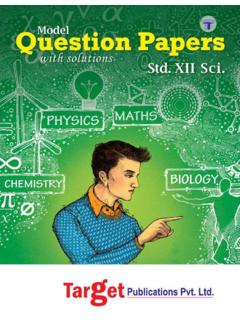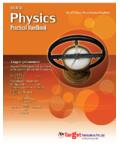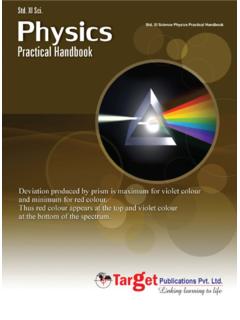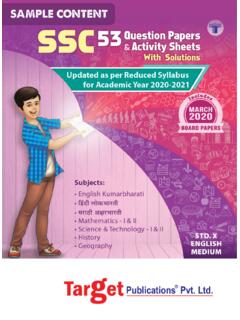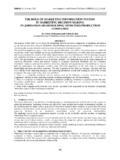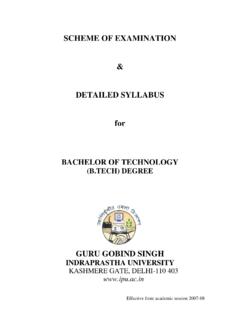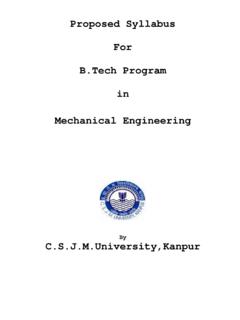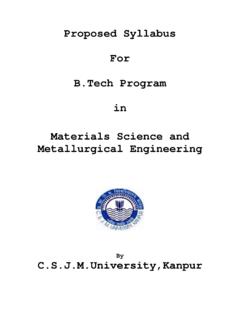Transcription of Best of luck to all the aspirants! - …
1 No part of this book may be reproduced or transmitted in any form or by any means, ROM/Audio Video Cassettes or electronic, mechanical including photocopying; recording or by any information storage and retrieval system without permission in writing from the Publisher. STD. XI Sci. Perfect Mathematics - I Printed at: Dainik Saamna, Navi Mumbai Written as per the revised syllabus prescribed by the Maharashtra State Board of Secondary and Higher Secondary Education, Pune. TEID : 906 Salient Features Exhaustive coverage of entire syllabus. Covers answers to all textual and miscellaneous exercises. Precise theory for every topic. Neat, labelled and authentic diagrams.
2 Written in systematic manner. Self evaluative in nature. Practice problems and multiple choice questions for effective preparation. Fifth Edition: May 2015 Preface In the case of good books, the point is not how many of them you can get through, but rather how many can get through to you. Std. XI Sci. : PERFECT MATHEMATICS - I is a complete and thorough guide critically analysed and extensively drafted to boost the students confidence. The book is prepared as per the Maharashtra State board syllabus and provides answers to all textual questions. At the beginning of every chapter, topic wise distribution of all textual questions including practice problems has been provided for simpler understanding of different types of questions.
3 Neatly labelled diagrams have been provided wherever required. Practice Problems and Multiple Choice Questions help the students to test their range of preparation and the amount of knowledge of each topic. Important theories and formulae are the highlights of this book . The steps are written in systematic manner for easy and effective understanding. The journey to create a complete book is strewn with triumphs, failures and near misses. If you think we ve nearly missed something or want to applaud us for our triumphs, we d love to hear from you. Please write to us on : Best of luck to all the aspirants! Yours faithfully, Publisher No. Topic Name Page No. 1 Angle and It s Measurement 1 2 Trigonometric Functions 22 3 Trigonometric Functions of Compound Angles 65 4 Factorization Formulae 95 5 Locus 116 6 Straight Line 142 7 Circle and Conics 202 8 Vectors 277 9 Linear Inequations 320 10 Determinants 367 11 Matrices 415 1 Publications Pvt.
4 Ltd. Target Chapter 01: Angle and it s Measurement Type of Problems Exercise Q. Nos. Coterminal angles (i. to iv.) Practice Problems (Based on Exercise ) (i., ii.) Degree measure and radian measure (i. to vii.) (i. to vii.) (i., ii.) , 6, 7 (i., ii.) , 10, 11, 12, 13, 14 Practice Problems (Based on Exercise ) (i. to v.) (i. to iv.) (i. to iii.) , 6, 7, 8 (i., ii.) Miscellaneous (i., ii.) (i., ii.) (i. to iii.) , 5, 13, 14, 15, 16, 17, 18, 20 Practice Problems (Based on Miscellaneous) (i., ii.) (i., ii.) , 4, 5, 6, 13, 14, 15 (i., ii.), 16, 19 Length of an arc , 2, 3, 4, 5 Practice Problems (Based on Exercise ) , 2, 3, 4, 5 Miscellaneous , 8, 9, 10, 19 Practice Problems (Based on Miscellaneous) , 9, 10, 11, 17, 18 Area of a sector , 8, 9, 10 Practice Problems (Based on Exercise ) , 8, 9, 10 Miscellaneous Practice Problems (Based on Miscellaneous) Length of an arc and area of a sector Practice Problems (Based on Exercise ) Miscellaneous , 12 Practice Problems (Based on Miscellaneous) Angle and it s Measurement 01 Publications Pvt.
5 Ltd. Target Std. XI Sci.: Perfect Maths -I2 Syllabus: Directed angles, zero angle, straight angle, coterminal angles, standard angles, angle in a quadrant and quadrantal angles. Systems of measurement of angles: Sexagesimal system (degree measure), Circular system (radian measure), Relation between degree measure and radian measure, length of an arc of a circle and area of sector of a circle. Introduction In school geometry we have studied the definition of angle and trigonometric ratios of some acute angles. In this chapter we will extend the concept for different angles. You are familiar with the definition of angle as the union of two non-collinear rays having common end point.
6 But according to this definition measure of angle is always positive and it lies between 0 to 180 . In order to study the concept of angle in broader manner, we will extend it for magnitude and sign. The measurement of angle and sides of a triangle and the inter-relation between them was first studied by Greek astronomers Hipparchus and Ptolemy and Indian mathematicians Aryabhatta and Brahmagupta. Directed angles Suppose OX is the initial position of a ray. This ray rotates about O from initial position OX and takes a finite position along ray OP. In such a case we say that rotating ray OX describes a directed angle XOP. In the above figure, the point O is called the vertex.
7 The ray OX is called the initial ray and ray OP is called the terminal ray of an angle XOP. The pair of rays are also called the arms of angle XOP. In general, an angle can be defined as the ordered pair of initial and terminal rays or arms rotating from initial position to terminal position. The directed angle includes two things i. Amount of rotation (magnitude of angle). ii. Direction of rotation (sign of the angle). Positive angle: If a ray rotates about the vertex (the point) O from initial position OX in anticlockwise direction, then the angle described by the ray is positive angle. In the above figure, XOP is obtained by the rotation of a ray in anticlockwise direction denoted by arrow.
8 Hence XOP is positive , + XOP. Negative angle: If a ray rotates about the vertex (the point) O, from initial position OX in clockwise direction, then the angle described by the ray is negative angle. In the above figure, XOP is obtained by the rotation of a ray in clockwise direction denoted by arrow. Hence XOP is negative angle , XOP. Angle of any magnitude: i. Suppose a ray starts from the initial position OX in anticlockwise sense and makes complete rotation (revolution) about O and takes the final position along OX as shown in the figure (i), then the angle described by the ray is 360 . In figure (ii) initial ray rotates about O in anticlockwise sense and completes two rotations (revolutions).
9 Hence, the angle described by the ray is 2 360 = 720 . P Initial ray O Terminal ray X Vertex P Initial ray O+ve angle Terminal rayX P Initial ray O ve angle Terminal rayX Fig. (i) O XFig. (ii) O X 3 Publications Pvt. Ltd. Target Chapter 01: Angle and it s Measurement In figure (iii) initial ray rotates about O in clockwise sense and completes two rotations (revolutions). Hence, the angle described by the ray is 2 360 = 720 ii. Suppose a ray starting from the initial position OX makes one complete rotation in anticlockwise sense and takes the position OP as shown in figure, then the angle described by the revolving ray is 360 + XOP.
10 If XOP = , then the traced angle is 360 + . If the rotating ray completes two rotations, then the angle described is 2 360 + = 720 + and so on. iii. Suppose the initial ray makes one complete rotation about O in clockwise sense and attains its terminal position OP, then the described angle is (360 + XOP). If XOP = , then the traced angle is (360 + ). If final position OP is obtained after 2,3,4, .. complete rotations in clockwise sense, then angle described are (2 360 + ), (3 360 + ), (4 360 + ), .. Types of angles Zero angle: If the initial ray and the terminal ray lie along same line and same direction , they coincide, the angle so obtained is of measure zero and is called zero angle.
